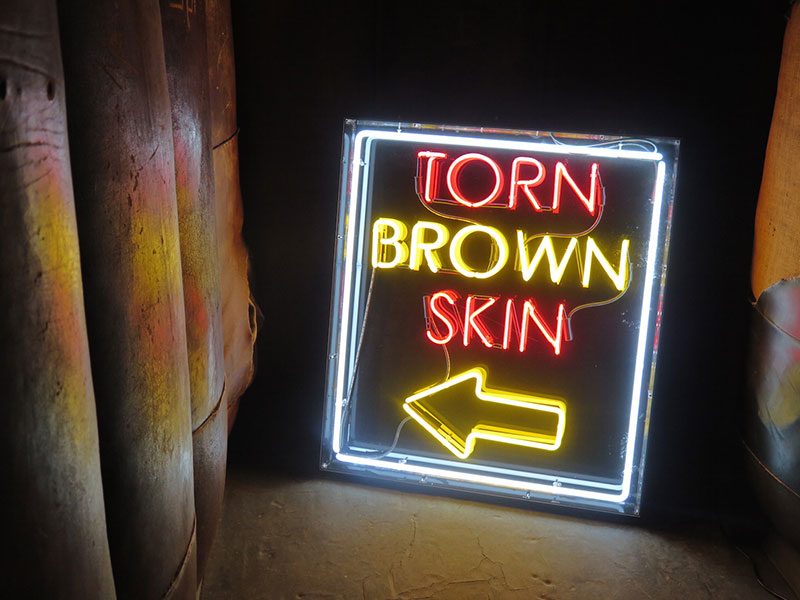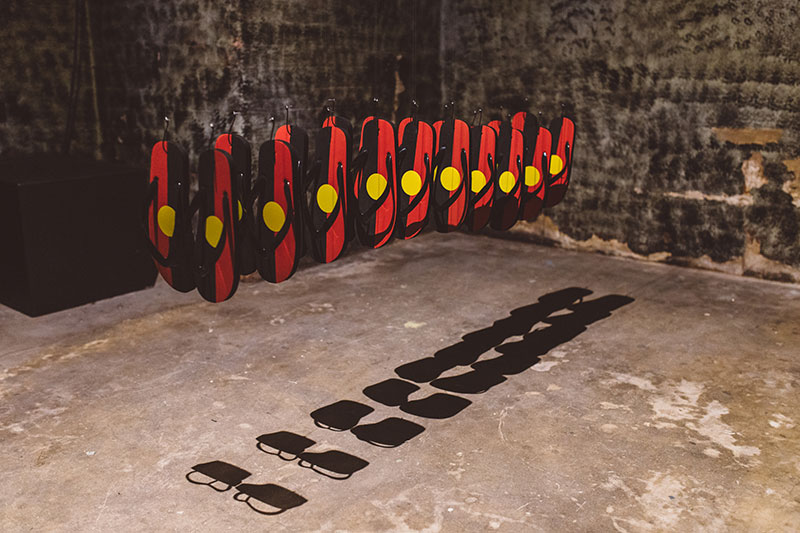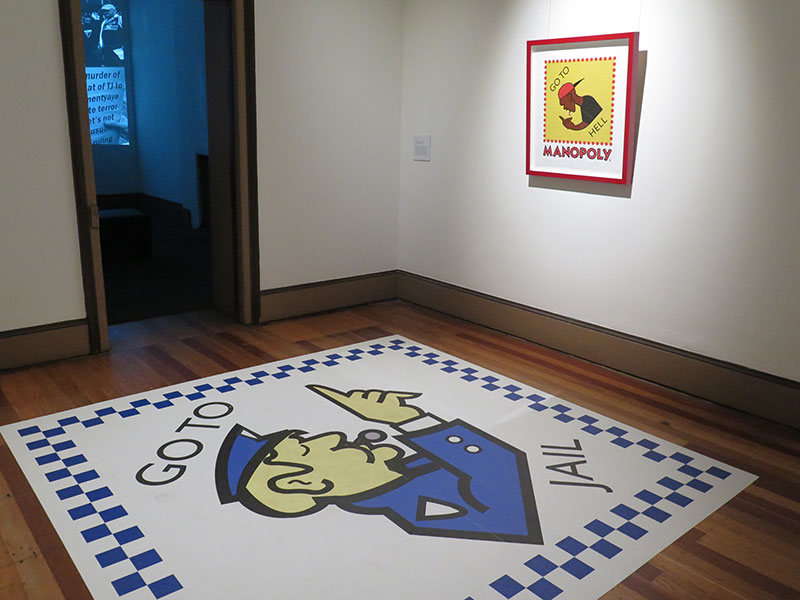
The Lock Up is a contemporary art space in Newcastle, NSW, located inside a colonial-era police station that was last in operation in 1982. The rare heritage- listed cells and former exercise yard have literally provided a template set in stone for the various exhibitions that I’ve viewed over recent years, many of them engaging with the venue’s site-specific nature. While there is a main gallery, most of the exhibition space is discovered by entering a labyrinth of tiny nineteenth-century holding cells, replete with inmates’ graffiti etched into the walls. Indeed, every time the threshold of the building is crossed you’re guaranteed an eerie confluence of past and present; where art can never be completely divorced from its context. Entering The Most Gaoled Race on Earth, you half expect a sideshow spruiker to shout you in, as if this sorry statistic (per capita the Aboriginal and Torres Strait Islander people in Australia are the most incarcerated in the world) is a claim to fame. The carnivalesque is continued as the first in-your-face image, Hungmen, looms large: a bright yellow, canvas banner depicting a black stick figure hanging from a hangman’s noose, the ten letter word underneath reads A-B-O-R-I-G-I-N-A-L.
Artist Blak Douglas described the opening of this exhibition as “the party anyone who has been jailed never had”. By all accounts it was packed, with speakers including local resident Joe Weatherall, brother of Lloyd Boney whose death in 1987 (police stated that he was found hanging by a football sock in a Brewarrina lock up) was one of many which prompted the 1989 royal commission into Aboriginal deaths in custody. The artists and the gallery developed myriad connections with members of Aboriginal communities from the Hunter region, and, obviously critical to the show’s gestation, was the decade-long friendship between Sydney-based Indigenous artist Douglas and his non-Indigenous collaborator Adam Geczy. As they write in their artist statement: “The works in this exhibition are prompted not by the spirit of ‘reconciliation’, or of conciliation or of proselytization. They are prompted by anger. There is a great deal of humour that abuts the more somber work, but it is a kind of laughter that occurs from the inability to express sorrow.” The spirit of this show emanates inexorably, irascibly and ironically out of the space itself, already halfway there. Any idea of an artistic veneer is ripped open, like the leather of the padded cell, illuminated by a neon sign “Torn Brown Skin”.

Trophy Room, one of the most confronting installations in the exhibition, is comprised of 130 red, black and yellow rope nooses hanging from the iron bars above the exercise yard. I’m there on a quiet Saturday over Easter, the innocuousness and simplicity of the material reminds me of going to Bunnings or Spotlight, yet a palpable grief befits the cold silence of the environment and fills the space. While it stands as a symbolic memorial en masse, there’s also the sense that every individual unit represents a particular life taken in custody. The wall text for this work reminds us that while the Aboriginal flag may be flown in front of more and more official buildings, its colours here attest to ongoing atrocity. The installation’s title siphons the shameful spirit of Australian racism: “So is not a black man’s corpse another white man’s trophy?”.
In an adjacent room is a digital documentary projection of the annual T. J. Hickey memorial march on the streets of Redfern, which has been held since his death in 2004. Recently I was in Redfern, having a coffee at Breadfern organic bakery, a reminder of the rapid gentrification of the suburb where the extended Hickey family each year lay their wreaths at the base of the Waterloo towers (now slated for demolition). The psychogeography of the exhibition is stretched further when I enter a cell with a grainy black-and-white video of Indigenous actor Richard Green reading his poetry, directly projected onto the wall. It’s as if the materiality of the Lock Up is being altered at every turn, and a history of confinement is being potently, and now poetically, commemorated and released.
The accompanying wall texts for each work in this exhibition are integral paratexts, and the artists have dispensed with any pretense of formal neutrality. BOONG!, an image of a pistol firing a flag saying BOONG! (instead of the expected BANG!) satirises the “abhorent treatment of Aboriginal return service-persons” in a “bold and poignant POP ART style”. I find myself learning about the word’s etymology which originated “from the name of the first recognised Aboriginal mediator to the colony Boongaree of the Botany Bay tribe”. The artists provide a vernacular commentary, combining witty turns-of-phrase with hard-hitting polemic. In Manopoly, there’s a call and response between a printed floor graphic of the “Go to Jail” monopoly square, and a “Go to hell” digital wall print with an Aboriginal figure in the centre.
The wall text for this work contains the statistic that “ONE-IN-FOUR” Indigenous people are locked up, and that “near TWO-HUNDRED Blak Fullas have met their death while in custody of Police although NO POLICE OFFICER HAS BEEN CHARGED. To add salt to the wound … prisons are being built and NAMED Aboriginal names. As we move further toward an imminent PRIVATISATION of prisons (as per the USA) ... one may wonder just how many Blakfullas will be incarcerated by 2030”. The striking Hung Ten, ten pairs of rubber thongs suspended above the ground and printed with the Aboriginal flag, is dedicated to the Boney family: each pair representing the ten- year period of the royal commission. The wall text notes how few of the commission’s over 330 recommendations have since been implemented.

As I leave the exhibition I speak to a woman who is documenting the show. She tells me more about Douglas’ work: his portrait of Uncle Max Eulo was hung in the Archibald last year, and while portraits of Indigenous subjects have won the prize, no Indigenous painter has ever taken the gong.
An exhibition such as The Most Gaoled Race on Earth is clearly a collaboration by artists who are making hardline political work, eschewing forms of cultural tokenism. Audience reception is an important facet of this show, as recorded in the gallery’s official visitor book (where most comments respond to the overwhelming power of the exhibition, although some still trot out the kind of “get over it” sentiment recently revived by Kyle Sandilands in response to the UNSW invasion versus discovery debate). I preferred being privy to the more idiosyncratic responses viewers are invited to leave on chalkboards in a cell where they are asked questions such as “What my Mum and Dad taught me about Aboriginal culture is …”, and someone has written DEADLY in capitals after the ellipsis.
As a follow up on The Most Gaoled Race on Earth, Douglas and Geczy are staging the second part of their project, The Most Stolen Race on Earth, later in the year at Darwin’s Northern Centre for Contemporary Art.


